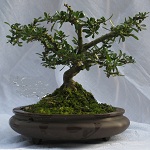Callicarpa japonicum
+3
JimLewis
Leo Schordje
fiona
7 posters
Page 1 of 1
 Callicarpa japonicum
Callicarpa japonicum
Any suggestions for getting my Shohin sized Callicarpa to flower and fruit would be very welcome. I'm getting conflicting stories about hard pruning during the growing season to promote fruiting as information sources online all seemed to suggest it flowers on new wood. To that extent I have not pruned this growing season and as you can see it has put on a lot of leaf but no sign of flower/fruit yet. It's in a sunny position but not full sun. I have followed the advice about not over-fertilising it but wonder if a high K feed (tomato feed etc) rather than the blander seaweed I use might help.
Remember it's in the wet and not overly warm (max 20C and that's only been on about 12 days this "summer" - the rest has been nearer 11 or 12C) west of Scotland.


Remember it's in the wet and not overly warm (max 20C and that's only been on about 12 days this "summer" - the rest has been nearer 11 or 12C) west of Scotland.


Last edited by fiona on Sat Aug 11, 2012 9:23 am; edited 1 time in total

fiona- Member
 not sure, just sharing a thought.
not sure, just sharing a thought.
I really don't know the answer, so why am I commenting? I'll admit to wanting to kill some time between unpleasant chores. 
In the USA I really only recall seeing beauty bush doing well somewhat south of me (Chicago) were summers are rather hot, temps to 30 or more C. (above 90F) regularly off and on all summer long. So temperature is a good guess. But I'm guessing.
Second thought, continue to let the new growth grow into next year's flowering season. This will not help the shape of the tree, but perhaps they do only bloom on the year previous wood. You need to see what the age of the wood is, if/when it blooms.
Third thought. About fertilizer.
If the color and health of the foliage is good, your fertilizer regime is good enough. Be cautious about high K fertilizers. Excess potassium (K) can block uptake of Calcium and Magnesium. The symptoms will look like Ca/Mg deficiency, but the cause will be excess K. This will not be a common situation, but if you are trying to push some plants into rapid growth with a heavy fertilizer program, this situation can occasionally happen.
Trees really only need about 1.5 to 2 parts of K for every part of N to grow, anything over that is an excess. However, don't panic, K is the most soluble of all nutrients (mobile in some discussions). This means that every time one waters the bulk of the K can be washed right out of the soil. Rain in particular can flush K out of the soils and the plants. It is only an occasional situation where K becomes a specific issue as an excess. It is a needed nutrient, so K deficiency is also a situation to be avoided, K deficiency is probably more common than K excess, but it is something to keep in mind, especially if you are not getting much rain, and like myself tend to continuously feed when you water.
Fourth thought.
The nutrient that can trigger blooming in many species (I use it on orchids) is Magnesium, I supplement it using Magnesium Sulfate, available here very inexpensively as 'Epsom Salts'. I use roughly 1/2 teaspoon per gallon, or by volume about 5 ml to 8 liters of water. It would be safe to go to double that dose, especially if you get rain regularly. I prefer to stay on the dilute side. Irrigate with this solution twice within a week, then return to your normal program. Do this once a month for 2 months in the early spring, and again in the once in the late fall after the trees have gone largely dormant. This should help trigger spring blooms without being so strong as to stress the trees.
In the USA I really only recall seeing beauty bush doing well somewhat south of me (Chicago) were summers are rather hot, temps to 30 or more C. (above 90F) regularly off and on all summer long. So temperature is a good guess. But I'm guessing.
Second thought, continue to let the new growth grow into next year's flowering season. This will not help the shape of the tree, but perhaps they do only bloom on the year previous wood. You need to see what the age of the wood is, if/when it blooms.
Third thought. About fertilizer.
If the color and health of the foliage is good, your fertilizer regime is good enough. Be cautious about high K fertilizers. Excess potassium (K) can block uptake of Calcium and Magnesium. The symptoms will look like Ca/Mg deficiency, but the cause will be excess K. This will not be a common situation, but if you are trying to push some plants into rapid growth with a heavy fertilizer program, this situation can occasionally happen.
Trees really only need about 1.5 to 2 parts of K for every part of N to grow, anything over that is an excess. However, don't panic, K is the most soluble of all nutrients (mobile in some discussions). This means that every time one waters the bulk of the K can be washed right out of the soil. Rain in particular can flush K out of the soils and the plants. It is only an occasional situation where K becomes a specific issue as an excess. It is a needed nutrient, so K deficiency is also a situation to be avoided, K deficiency is probably more common than K excess, but it is something to keep in mind, especially if you are not getting much rain, and like myself tend to continuously feed when you water.
Fourth thought.
The nutrient that can trigger blooming in many species (I use it on orchids) is Magnesium, I supplement it using Magnesium Sulfate, available here very inexpensively as 'Epsom Salts'. I use roughly 1/2 teaspoon per gallon, or by volume about 5 ml to 8 liters of water. It would be safe to go to double that dose, especially if you get rain regularly. I prefer to stay on the dilute side. Irrigate with this solution twice within a week, then return to your normal program. Do this once a month for 2 months in the early spring, and again in the once in the late fall after the trees have gone largely dormant. This should help trigger spring blooms without being so strong as to stress the trees.

Leo Schordje- Member
 Re: Callicarpa japonicum
Re: Callicarpa japonicum
Dirr sits it in zone 5-8 and says it freezes to the ground at -5 but sprouts back. I've never seen C japonica in the flesh, but am familiar with C. americana, which grows wild in the areas south of me. It is quite tender in cold weather. It also has stems with central pithy, chambered core and its branches are very brittle.
My guess is that you may be a tad chilly for it to bloom and fruit.
My guess is that you may be a tad chilly for it to bloom and fruit.

JimLewis- Member
 Re: Callicarpa japonicum
Re: Callicarpa japonicum
I may stick it in the glasshouse then.
The foliage is healthy enough so I don't want to upset the feeding regime if at all possible. I've seen two or three with the berries on over here but that may be just after they've been brought in from Japan and/or it may be because those ones were older plants and had been grown as single trunked trees rather than the multi-trunk that this one is.
Would love to hear from anyone who has one, especially over here.
The foliage is healthy enough so I don't want to upset the feeding regime if at all possible. I've seen two or three with the berries on over here but that may be just after they've been brought in from Japan and/or it may be because those ones were older plants and had been grown as single trunked trees rather than the multi-trunk that this one is.
Would love to hear from anyone who has one, especially over here.

fiona- Member
 Re: Callicarpa japonicum
Re: Callicarpa japonicum
I have had my calicapa jp.for a few years and it has had no pruning after the first tidy up when I got it. It survived outdoors in the winters of 2009/10 and 2010/11 under the snow and has had a few small purple flowers which became tiny berries. I admit to shamelessly neglecting it and it's fed with my other trees (irregularly with seaweed extract or phostrogene) so perhaps neglect is the way to make it flower. 

Jennyreyn- Member
 Re: Callicarpa japonicum
Re: Callicarpa japonicum
perhaps neglect is the way to make it flower.
True for more than a few plants.

JimLewis- Member
 Re: Callicarpa japonicum
Re: Callicarpa japonicum
perhaps neglect is the way to make it flower.
When you say neglect, I assume you mean letting it grow wild for a bit... and not starving or half dying
Have you tried starting feeding it with fertilizers that would promote flowering some 2 months before hand? Allow the plant to build up its reserves in order to flower up.

Xavier de Lapeyre- Member
 Re: Callicarpa japonicum
Re: Callicarpa japonicum
When you say neglect, I assume you mean letting it grow wild for a bit... and not starving or half dying
Both. It is a biological imperative for plants that are "suffering" to do their damnedest to bloom and produce seed, and thus ensure the passing on of their genetics. (A bit of pseudo-anthropomorphizing there, but . . . )
As one example, Wisteria as a group bloom most readily if their roots are either drowned in water or bone dry and on the point of dessication. The latter, however, tends more often than not to lead to the death of the plant, so keeping the pot mostly submerged in water over late winter and early spring is a better approach.

JimLewis- Member
 Callicarpa japonica (sic)
Callicarpa japonica (sic)
I have a C. dichotoma in my yard. I have seen C. japonica grown successfully as bonsai. You do not have to worry about second-year growth. Callicarpa blooms on current year's growth. However, it is possible that your plant may not be mature enough to bloom. Keep trying. Give it plenty of sun.
Iris
Iris

bonsaisr- Member
 Re: Callicarpa japonicum
Re: Callicarpa japonicum
Val, is yours a single trunk tree or a more shrubby structure like mine? It is possible that Iris is on to something here as although the main "trunk" of mine is old, the top growth is not. Certainly, the ones I've seen flowering/fruiting over here have all been single trunk trees.Jennyreyn wrote:I have had my calicapa jp.for a few years and it has had no pruning after the first tidy up when I got it. It survived outdoors in the winters of 2009/10 and 2010/11 under the snow and has had a few small purple flowers which became tiny berries. I admit to shamelessly neglecting it and it's fed with my other trees (irregularly with seaweed extract or phostrogene) so perhaps neglect is the way to make it flower.

fiona- Member
 Callicarpa japonica (sic)
Callicarpa japonica (sic)
It's too bad plants don't signal when they reach puberty the way animals do. 
Iris

Iris

bonsaisr- Member
 Re: Callicarpa japonicum
Re: Callicarpa japonicum
Hi Fiona. If it is any help we grow a Callicarpa on the south side of, and in the shelter of a large Philadelphus and an equally large Viburnum. We think the variety is "Bodinieri" - not bonsai. It has flowered and berried profusely for a few years now - but not this year, which even here in sunny Oxfordshire has been almost continuously dull and wet. It has flowered a little, but is not setting berries, which we put down to a lack of insects. We could be quite wrong! You have had even worse weather than us this year, so could it just be the season? We grow it in neutral garden soil and never feed it, but then it is not a bonsai. Yours looks well - maybe you'll have better luck next year? Cheers. Rick.
Rick36- Member
 Re: Callicarpa japonicum
Re: Callicarpa japonicum
Mine is a single trunk although it has put up a few suckers from the roots which I have removed. Alhough I have only had it 3 years the bark at the base is quite mature looking. I decided to give it a good haircut today so not likely to see any more flowers for a whilefiona wrote: Val, is yours a single trunk tree or a more shrubby structure like mine? It is possible that Iris is on to something here as although the main "trunk" of mine is old, the top growth is not. Certainly, the ones I've seen flowering/fruiting over here have all been single trunk trees.

Jennyreyn- Member
Page 1 of 1
Permissions in this forum:
You cannot reply to topics in this forum






